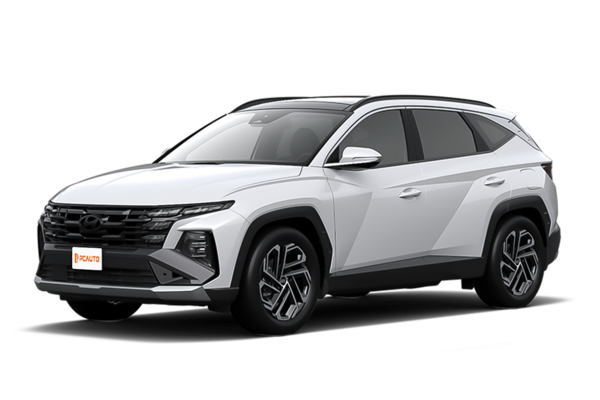Q
Is there a 2025 Tucson Hybrid?
As an automotive editor, regarding the question of whether the 2025 Tucson Hybrid will exist, Hyundai has not yet made any official announcements. However, judging by past model update cycles and global market trends, a hybrid version will most likely continue.
The current Tucson Hybrid pairs a 1.6L turbocharged engine with an electric motor, delivering a combined output of around 230 horsepower. It comes with a 6-speed automatic transmission and HTRAC all-wheel drive, offering better fuel efficiency than the conventional gas-powered model. If a new version arrives, expect upgrades in battery efficiency or smart driving assists—possibly a higher-capacity lithium battery pack or the latest SmartSense system.
Hybrids are gaining popularity locally, as they cut fuel costs without relying on charging infrastructure. If launched, the Tucson Hybrid would compete directly with rivals like the Honda CR-V Hybrid. Keep an eye out for official updates later this year—Hyundai often unveils new models ahead of year-end auto shows. Also, watch for tech specs from the related Santa Fe Hybrid, as the two typically share powertrains.
Special Disclaimer: This content is published by users and does not represent the views or position of PCauto.
Related Q&A
Q
What engine is in a 2025 Hyundai Tucson?
The 2025 Hyundai Tucson comes with a variety of engine configurations. The Tucson Style G2.0 MPi is equipped with a 2.0-liter naturally aspirated engine with a displacement of 1999mL, delivering maximum horsepower of 156PS, maximum power of 115kW, and maximum torque of 192N·m. The Tucson Prime 1.6T-GDi features a 1.6-liter turbocharged engine with a displacement of 1598mL, producing maximum horsepower of 180PS, maximum power of 132kW, and maximum torque of 264N·m. The Tucson Prestige 1.6T-GDi AWD also uses a 1.6-liter turbocharged engine, sharing identical power specifications with the Prime 1.6T-GDi variant. The Tucson Prestige 1.6T-GDi Hybrid employs a hybrid system that combines a 1.6-liter turbocharged engine with an electric motor, where the engine generates maximum horsepower of 180PS, the electric motor provides maximum horsepower of 65PS, the system's total output reaches 235PS, and the system's combined torque measures 367N·m. These diverse engine configurations cater to consumers' varying power requirements and driving preferences.
Q
What should I pay for a 2025 Tucson?
The anticipated pricing for the 2025 Tucson is expected to vary depending on trim levels and configurations. Based on the current model’s price range, the entry-level version may start around RM120,000, while higher-end hybrid or AWD variants could reach RM160,000 to RM180,000. Official pricing will be confirmed upon launch.
The new Tucson will likely carry over the sleek design and practical tech features of the current model, including a large infotainment screen, advanced driver-assistance systems, and more efficient turbocharged or hybrid powertrain options—making it a solid choice for families prioritizing value and functionality.
When considering a purchase, keep an eye out for promotions like low-interest financing, free maintenance packages, or trade-in incentives, which can help reduce ownership costs. Plus, as a globally popular model, the Tucson benefits from a widespread service network and readily available parts, keeping long-term maintenance manageable. If you plan to keep the car for years, opting for a trim with an extended warranty might be a smart move.
Q
How much is insurance on a 2025 Hyundai Tucson?
**Insurance Costs for the 2025 Hyundai Tucson**
The insurance premium for the 2025 Hyundai Tucson varies depending on the specific model, engine capacity, type of coverage, and driver profile (age, driving record, etc.). On average, comprehensive insurance for a new Tucson may range between RM2,500 to RM5,000 per year, but it’s best to get a personalized quote from insurers.
Factors affecting premiums include the car’s market value, safety features, anti-theft systems, and the insurer’s risk assessment policies—for example, models with Advanced Driver Assistance Systems (ADAS) may qualify for discounts. You can also lower costs by opting for a higher excess or leveraging your No-Claim Discount (NCD).
Before buying, compare policies across insurers and check the fine print—like coverage for natural disasters or third-party liability—to find the right protection for your needs.
Q
Are all 2025 Hyundai Tucson AWD?
**2025 Hyundai Tucson AWD Availability**
Not all trims come standard with AWD—it depends on the version and powertrain. Base models typically stick with front-wheel drive (FWD) for better fuel economy and lower pricing, while higher trims or sport-oriented variants may offer AWD as an option or standard equipment, especially with turbocharged engines.
Hyundai’s AWD system improves traction on wet roads or winding routes, making it a smart pick for rainy climates or frequent mountain driving. Just note: it adds a slight hit to fuel efficiency and upfront cost. If you need four-wheel drive, check your local dealer’s specs or look for the "HTRAC" badge (Hyundai’s smart AWD system).
Competitors like the Honda CR-V or Toyota RAV4 follow a similar strategy, reserving AWD for select trims. Where the Tucson stands out? Its hybrid powertrain can pair with AWD—a rare combo that balances efficiency and all-weather capability. Cross-shop accordingly.
Q
How much is a Hyundai Tucson 2025 resale value?
As an automotive editor discussing the projected resale value of the 2025 Hyundai Tucson, there’s no official data yet since the model hasn’t hit the market. Resale values are typically assessed post-launch based on factors like market performance, trim options, ownership volume, and maintenance costs.
For now, we can look to the current Tucson’s depreciation trends as a reference. Generally, a three-year-old Tucson retains about 60-70% of its value, while a five-year-old model holds around 50-60%—though this varies with condition, mileage, and service history.
Key factors influencing resale value include:
- **Powertrain reliability** (e.g., differences between the 1.6T turbo and hybrid variants)
- **Tech features** (e.g., how widely ADAS systems are adopted)
- **Market competition** (e.g., demand for rivals like the Honda CR-V or Toyota RAV4)
To maximize future resale, opt for popular configurations and keep meticulous maintenance records. If resale value is a priority, check local used-car platforms or dealer listings for historical transaction data on similar models.
Q
When did 2025 Tucson come out?
The 2025 Hyundai Tucson has begun its global rollout in Q1 2024, with local market availability expected by mid-to-late 2024. As the latest iteration of Hyundai's best-selling SUV lineup, this model retains the brand's signature design language while sporting more futuristic upgrades to the front grille, lighting clusters, and body contours.
Inside, you'll find a dual-screen setup and a smarter infotainment system. Powertrain options will likely include a 2.0L naturally aspirated engine, a 1.6T turbocharged unit, and a hybrid variant. Notably, the new Tucson gets significant upgrades in active safety tech, featuring enhanced smart cruise control and automated parking assist.
For those in the market for a new ride, keep an eye out for dealer test-drive events to experience its improved cabin space and driving dynamics firsthand. It’s also worth cross-shopping rival models in the segment to compare specs and pricing before making a decision.
Q
Will the 2025 Tucson have a larger touchscreen?
Based on current information, the 2025 Tucson is expected to upgrade its interior tech features, likely including a larger touchscreen to keep pace with the industry trend favoring big displays and smart connectivity. Exact screen dimensions and functionality details will require official confirmation.
Hyundai has been steadily refining its infotainment systems—the current Tucson already offers a 10.25-inch touchscreen with wireless CarPlay, so the new model may further enhance display quality or integrate more localized apps. Beyond the screen, potential upgrades could include improved voice control or advanced driver-assistance features, which often accompany such tech refreshes.
If in-car connectivity is a priority, keep an eye on official updates while cross-checking specs against rivals like the CR-V or RAV4. This kind of comparison helps gauge how the new Tucson stacks up in practicality.
Q
How much will the 2025 Hyundai Tucson cost?
The anticipated price range for the 2025 Hyundai Tucson is expected to be between RM120k to RM160k, depending on trim levels and powertrain options. The base 2.0L naturally aspirated variant will likely sit at the lower end, while the 1.6T turbo hybrid or top-spec N Line could push toward the higher bracket.
This SUV retains the brand’s signature parametric diamond grille and may feature upgraded next-gen driver-assist tech, like remote parking or highway lane-change automation. Competing against rivals such as the Honda CR-V or Toyota RAV4 (typically priced around RM130k–RM180k), the Tucson stands out with perks like a longer factory warranty (usually 5 years/unlimited mileage) and standard ventilated seats.
Notably, Hyundai’s recent hybrid advancements could give the Tucson Hybrid a combined fuel economy as low as 5L/100km—a big plus for city drivers facing heavy traffic. If you’re interested, keep an eye out for the official Q3 launch for confirmed specs and potential promotions, like free service packages or low-interest financing.
Q
What is the range of the 2025 Tucson?
The all-electric 2025 Tucson is expected to deliver around 450 km of range (WLTP), though official figures may vary. This should cover daily commutes and short trips with ease, plus it supports fast charging—just 30 minutes to 80%. Opt for the hybrid version, and you’re looking at 800+ km on a full tank, striking a balance between fuel efficiency and long-distance practicality.
Keep in mind, real-world range depends heavily on driving style, terrain, and weather. Pro tip: use regen braking and select the right drive mode to maximize efficiency. Competitors like the CR-V Hybrid or RAV4 Prime offer 500-900 km, but the Tucson pulls ahead with smarter tech—think standard lane-keeping assist and adaptive cruise.
Charging infrastructure? DC fast chargers are now widespread in major Chinese cities, and a home wallbox makes overnight top-ups a breeze. Before deciding, test-drive both powertrains and check the official energy consumption data for a full picture.
Q
What engine goes in the 2025 Hyundai Tucson?
The 2025 Hyundai Tucson is expected to carry over its current powertrain lineup, offering multiple engine options to suit different needs. Buyers can choose between the 2.0L MPI naturally aspirated gasoline engine (156 hp/192 Nm), the peppy 1.6L T-GDi turbocharged gasoline unit (180 hp/265 Nm), or the 1.6L turbo hybrid system delivering a combined 230 hp. Diesel lovers in select markets might also get the 2.0L diesel option (186 hp/416 Nm), though final specs are subject to official confirmation.
Hyundai has struck a nice balance between fuel efficiency and performance in the Tucson's powertrains, with the hybrid variant being the go-to for eco-conscious drivers who want to save at the pump. As one of the brand's best-selling SUVs, the Tucson benefits from Hyundai's Smartstream engine technology, which optimizes combustion efficiency and thermal management. It pairs with either a 7-speed dual-clutch or a 6-speed automatic transmission for smooth, predictable driving dynamics.
If you're after more spirited performance, the 1.6T is the sweet spot, while the hybrid makes the most sense for daily commutes. Hyundai's recent innovations, like the CVVD (Continuously Variable Valve Duration) tech, further enhance engine efficiency—definitely worth keeping an eye on.
Popular Cars
Model Year
Car Compare
Car Photo
Latest Q&A
Q
How reliable is a 2019 Porsche Macan?
The 2019 Porsche Macan delivers solid reliability, thanks to its proven 2.0T or 3.0T engines that offer consistent power delivery. The PDK dual-clutch transmission is another strong point—it’s both durable and buttery-smooth.
Porsche’s sporty DNA shines through in the Macan’s chassis tuning and all-wheel-drive system, yet it doesn’t compromise everyday comfort. Owner feedback suggests that sticking to the factory maintenance schedule keeps most examples running trouble-free, though be prepared for higher upkeep costs (as with any luxury vehicle).
Its strong resale value speaks volumes about its reputation for dependability. If you’re after driving thrills without sacrificing SUV practicality, the 2019 Macan is a compelling pick. Just be sure to get a pre-purchase inspection and verify full service history—it’ll pay off in the long run.
Q
How much is a 2019 Porsche worth?
The value of a 2019 Porsche depends on the model, mileage, condition, and specs. Take the popular Cayenne, for example—used ones typically go for between RM300k to RM500k. A 911 Carrera might range from RM500k to RM800k, while an entry-level 718 Boxster or Cayman could be around RM250k to RM400k. For luxury sedans like the Panamera, expect prices between RM350k to RM600k, but always check the actual condition and option list.
Porsches hold their value well, especially limited editions or high-performance GT models, but maintenance costs and service history play a big role in resale pricing. If you're buying, stick to official certified pre-owned channels or get a professional inspection. Always verify warranty transfers and repair records.
Pro tip: Compare listings on local used-car platforms and check recent sales data—market demand and inventory fluctuations affect pricing. Also, factory options (like sport packages or premium audio) can boost resale value, while accident history or multiple owners might slash the price by 10-20%.
Q
Does the 2019 Macan have a good sound system?
The 2019 Porsche Macan delivers an impressive audio performance, particularly with the optional Bose® Surround Sound System or the top-tier Burmester® High-End Surround Sound System—both offering an immersive listening experience.
The Bose® setup packs 14 speakers with 665 watts of total power, delivering crisp audio and punchy bass perfect for pop and electronic music. Meanwhile, the Burmester® system steps it up with 16 speakers and 1,000 watts, creating a wider soundstage and superior detail reproduction—ideal for classical or high-resolution tracks.
Both systems integrate seamlessly with Porsche’s standard Communication Management (PCM), supporting Apple CarPlay and multiple audio sources. If sound quality is a priority, be sure to specify your audio preference at purchase—the base model only comes with a standard speaker setup.
For the best performance, play lossless files via USB or high-quality Bluetooth codecs, and keep the system firmware updated for optimal operation.
Q
What is the resale value of a 2019 Macan?
The resale value of a 2019 Porsche Macan depends on factors like condition, mileage, specs, and service history. Current used prices hover between RM250k to RM350k, with higher trims commanding premium prices. As Porsche's entry SUV, the Macan holds its value better than most rivals thanks to brand prestige and sporty DNA – especially models optioned with Sport Chrono or full leather interiors fetching stronger money.
Pro tip: Get a pre-sale inspection and organize your maintenance paperwork – this really helps maximize resale. Macans move quickly in our local used market, with 3-5 year-old examples being the sweet spot when depreciation levels off. If you're upgrading, consider Porsche Approved Certified pre-owned – you'll pay a slight premium over private sales, but the extended warranty and factory refurbishment save headaches down the road.
Q
Is a 2019 Porsche Macan a good car?
The 2019 Porsche Macan is a well-rounded luxury SUV that stays true to Porsche's performance DNA while delivering everyday practicality. It comes with your choice of a peppy 2.0T or more powerful 3.0T engine, paired with Porsche's brilliant 7-speed PDK transmission that shifts like butter. The chassis strikes that sweet spot between sporty handling and comfortable cruising - perfect for both city commutes and weekend backroad blasts.
Inside, you'll find Porsche's typical top-notch craftsmanship with a standard 10.9-inch touchscreen featuring Apple CarPlay. Just don't expect limo-like rear legroom. These things hold their value surprisingly well, though maintenance will cost you more than your average SUV - but then again, you get Porsche's excellent service network.
Among its competitors, the Macan stands out for its driver engagement. If you want more grunt, step up to the Macan S or GTS. One pro tip: if you're shopping used, pay special attention to the PDK's condition and inspect the suspension components. Always better to go through Porsche's certified pre-owned program for that extended warranty peace of mind.
View MoreRelated News

Hyundai's Big Return to Malaysia: Top 5 Models Expected
MichaelMay 30, 2025

In Malaysia, which sliding door MPVs are available?
MichaelOct 30, 2025

Modern Ioniq 5 N Lands in Malaysia: Track-Level Performance Electric Vehicle is Here, Priced Possibly Below RM 400,000?
JohnSep 10, 2025

580,000 km & 87.7% Battery Health: Ioniq 5’s Incredible Durability
MichaelMay 6, 2025

Revolutionizing Hybrids: Hyundai’s New System vs. Toyota's Hybrid System
Kevin WongApr 22, 2025
View More


















Pros
Cons